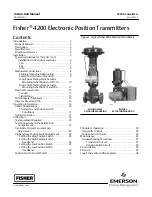
Instruction Manual
D200354X012
4200 Transmitters
March 2011
6
Check with your process or safety engineer for any additional measures that must be taken to protect against process
media.
If installing into an existing application, also refer to the WARNING at the beginning of the Maintenance section in this
instruction manual.
When a 4200 transmitter is ordered with an actuator, the factory mounts the transmitter and adjusts the zero and
span for the travel specified on the order. Make field wiring connections as described in the electrical connections
procedure and fine tune the transmitter to the application. Refer to the appropriate actuator and valve instruction
manuals to install the attached assemblies.
If the transmitter has been ordered separately, or removed for maintenance, perform the appropriate portion of the
Mechanical Connections, Electrical Connections, Potentiometer Alignment, and Calibration procedures.
The transmitter can be mounted in any of four positions. Mount the transmitter vertically or horizontally depending on
the application requirements. Refer to figures 15 through 23 for examples of typical actuator mounting assemblies.
As an aid to installation, and to understand the transmitter design in general, refer to figure 2 to see the location of the
transmitter compartment and the field wiring compartment. The transmitter compartment contains the transmitter
and/or the position switch circuit on the printed wiring board, associated wiring assemblies, adjustment
potentiometers, and the potentiometer that senses position. Remove the cover on the transmitter compartment to
gain access to this compartment. The transmitter compartment is adjacent to the
symbol on the housing.
Except for a 4211 or 4221 transmitter, the field wiring compartment contains a printed wiring board with the terminal
blocks (figure 4) for connecting field wiring and associated cable assemblies. It also contains the position switch relays
which are mounted on the printed wiring board. Remove the cap adjacent to the + and - symbols on the housing to
access this compartment.
For a 4211 or 4221 transmitter without position switch circuits, the field wiring compartment contains a barrier strip
for installation of the transmitter field wiring (figure 4).
Figure 2 shows the location of the ports into the field wiring compartment. Two ports are available for routing the
transmitter and/or position switch wiring into the transmitter housing. After transmitter installation, install a plug in
the unused port. When installing the transmitter, allow sufficient space for removing the covers to perform
maintenance and to make the wiring connections. Figure 2 also shows the basic transmitter outline dimensions.
Special Instructions for “Safe Use” and Installations in Hazardous
Locations
Certain nameplates may carry more than one approval, and each approval may have unique installation/wiring
requirements and/or conditions of “safe use”. These special instructions for “safe use” are in addition to, and may
override, the standard installation procedures. Special instructions are listed by approval.
WARNING
Failure to follow these conditions of “safe use” could result in personal injury or property damage from fire or explosion, or
area re‐classification.






































